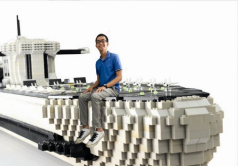READY, GET SET, LEGO!
PHOTO // Chai Sian Liang
How does one go about building a submersible aircraft carrier out of Lego bricks? Find out from Specialist Cadet Trainee (SCT) Teh Jun Hao, who built one as part of his entry application to the Singapore University of Technology and Design (SUTD).
In the world of Lego, life in plastic is certainly fantastic. These small building blocks have been a staple toy of many children, where your imagination and the number of Lego bricks you have are the only limitations to what you can create.
SCT Teh combined his love of Lego and military technology to design the RSS Trident, an aircraft carrier which also functions as a submarine.
"The three prongs of the trident represent the Army, Navy and Air Force: The RSS Trident is a formidable warship that can support ground forces with air strikes and achieve air supremacy through its huge fleet of aircraft," he explained.
Armed with plenty of ingenuity, patience and about 10,000 bricks from various old Lego sets, the 18-year-old put his design and construction skills to the test.
The result? A slick grey-and-white warship which measures 1.5m long and weighs about 20kg. Not only is it his biggest Lego model to date, the ship was also his first attempt at building something which incorporates robotics, such as a moving elevator mechanism and mechanised retractable armour.
Weeks of painstaking effort paid off when SCT Teh submitted a video of the construction process for his varsity application and successfully secured a place at SUTD.
Now who says Lego is only for kids?
PIONEER: What inspired you to build a submersible aircraft carrier?
SCT Teh: I am fascinated by military technology and most of my other creations have been warships, so I guess they reflect my interest in science and technology. It is always exciting to create something new, and the aircraft carrier is the largest warship afloat so the idea really appealed to me.
It wasn't easy planning for such a big-scale model so that took quite some time. The robotics system I used was quite old, so I had to search online for a patch to make the program compatible with my current computer system. I also did some research on the Internet to find out what kind of weapon systems this kind of ship usually has.
It took me one month to build it. The biggest challenge was designing the motorised components and making sure they could fit nicely inside the ship. I used a large variety of Lego pieces: some are from sets made specifically for shipbuilding, others were from general sets that can be used to build anything and some pieces were from a Lego robotics set.
Have you been a Lego enthusiast long?
Yes, I've been playing with Lego since I was five or six years old. The appeal of Lego is in its versatility because you are able to use them to build anything you can imagine.
And my inspiration to create new pieces comes from the desire to outdo myself as I create larger and more complex structures. If I had unlimited Lego bricks, I would build replicas of famous cities around the world.
What will you do with your Lego aircraft carrier now?
The aircraft carrier is displayed in my room and it will probably stay there till my ORD (Operationally-Ready Date) since I don't have much time to play with Lego now.
Currently, I'm a Specialist Cadet Trainee at Specialist Cadet School (SCS) Three and I just finished the foundation term of my course.
Before I enlisted, I knew that NS (National Service) would mean strict regimentation and tough physical training. I was from the National Cadet Corps (NCC), so I was a little more prepared compared to others. Of course, NCC is only about eight hours a week but here it's 24/7, so it was still quite tough adapting to life in the military.
What has been your most memorable experience in NS so far?
Completing tough training which I never imagined myself going through prior to enlistment, such as the 24km graduation route march in BMT (Basic Military Training).
During BMT, I managed to get only a pass for my IPPT (Individual Physical Proficiency Test). At the end of my foundation term at SCS, I achieved a Silver award. Seeing myself improve as training progresses keeps me going.
I am much fitter now and seeing myself becoming more independent has been the most rewarding takeaway from NS. Being more disciplined and independent definitely helps in your studies and career, and these are important values you'll need to be successful in life.
The aircraft carrier was put together using about 10,000 bricks from SCT Teh's old Lego sets.
Technical specifications of the RSS Trident
Length: 1.5m
Height: 35cm
Width: 45cm
Weight: 20kg
No. of bricks used: 10,000
No. of days to build: 30 days
Robotic components:
RCX (Robotic Command eXplorer) programmable brick
Elevator mechanism
Retractable armour










